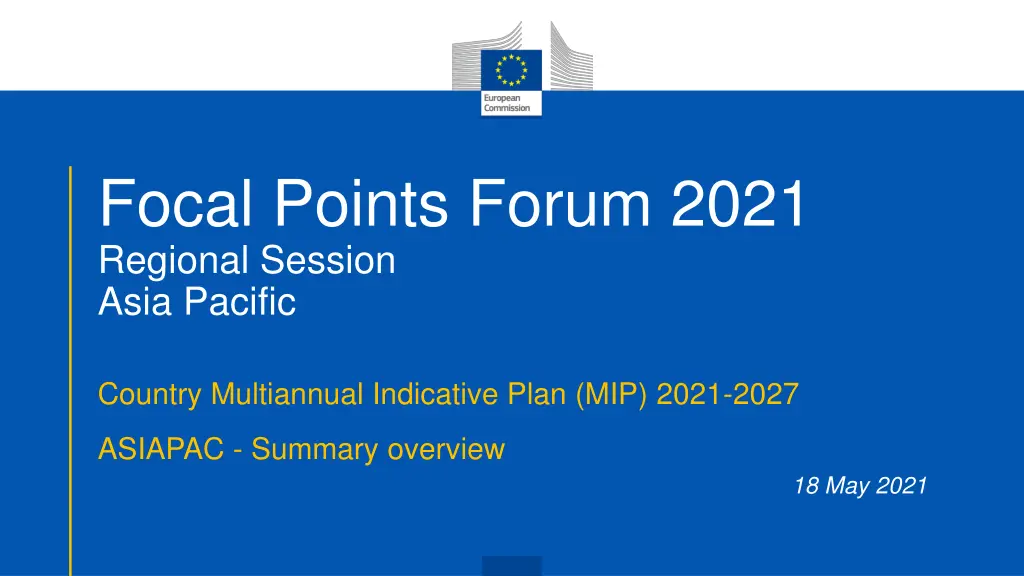
Analysis of Civil Society Engagement in Asia-Pacific Regional Session 2021-2027
Explore the consultation and mainstreaming of Civil Society Organizations (CSOs) in the Asia-Pacific region's Multiannual Indicative Plan (MIP) 2021-2027. Understand the varying levels of engagement and support for CSOs across different countries, shedding light on areas for improvement.
Download Presentation

Please find below an Image/Link to download the presentation.
The content on the website is provided AS IS for your information and personal use only. It may not be sold, licensed, or shared on other websites without obtaining consent from the author. If you encounter any issues during the download, it is possible that the publisher has removed the file from their server.
You are allowed to download the files provided on this website for personal or commercial use, subject to the condition that they are used lawfully. All files are the property of their respective owners.
The content on the website is provided AS IS for your information and personal use only. It may not be sold, licensed, or shared on other websites without obtaining consent from the author.
E N D
Presentation Transcript
Focal Points Forum 2021 Regional Session Asia Pacific Country Multiannual Indicative Plan (MIP) 2021-2027 ASIAPAC - Summary overview 18 May 2021
Analysis of consultations and mainstreaming of Civil Society Programming guidelines for country MIP: Inclusive consultation with CSO, including youth and women s organisations; Meaningful engagement of civil society in all priority areas; Support Measures for civil society The Mini-MIP countries - Indonesia, Turkmenistan, Kazakhstan, Malaysia, Thailand - for which there is no bilateral envelope, were not concerned by mainstreaming nor support measures for CS.
Consultations with Civil society This review is based on the summaries of the consultations that were annexed to the MIPs: Very good: Good: Middle: Weak: 7 MIPs out of 20. 8 MIPs out of 20 1 MIP out of 20 3 MIPs out of 20 Lesson learnt: in most cases, good level of consultations. A study will complement those initial findings.
Mainstreaming of Civil Society in the Priority Areas Very good: Good: Middle: Weak: 4 MIPs out of 20: Iraq, Uzbekistan, Vietnam, Pacific (Fiji+12) 5 MIPs out of 20 7 MIPs out of 20 4 MIPs out of 20 - Situations greatly differ from one country to another; - There is room for improvement. Need for more CSO mainstreaming; - But the overall space in which CSO operates has a tendency to shrink. These initial results illustrate the following: 4
ASIA-PACIFIC: Analysis of consultations and mainstreaming of Local Authorities (LAs) The present analysis is not exhaustive and is based on priority countries that were chosen by the EC based on their enabling environment for Local Authorities (LAs). NB: priority countries for Local Authorities in Asia-Pacific: Bhutan, Indonesia, Maldives, Myanmar, Nepal, Pakistan, Philippines, Sri Lanka, Timor Leste. Reminder of the key programming requirement for LAs from guidelines: - The programming exercise will follow an inclusive process encompassing broad and transparent consultation both at country/region and Headquarters levels with all relevant stakeholders [ ] including local authorities, traditional authorities when relevant, private sector... - How the MIP at country level will ensure meaningful engagement of civil society in all priority areas, and support to local authorities.
TRENDS Consultation 1. For most of the EUDs (7 out of 8) there is no evidence that Local Authorities have been consulted during the programming period. Consultation exercises have largely ignored LAs, as most countries only consulted with EUMs, other donors, CSOs and the national government.
Mainstreaming 2. In most cases, EUDs have missed the opportunity to include LAs since some of their work is directly related to strengthening decentralization and democratic governance at local level. The same is true for MIPs targeting cities and sectors relevant to LAs like mobility, waste, water, resilience, etc. 3. This situation can and should be improved during implementation, since in many countries, priority sectors could benefit from direct involvement of sub-national authorities, in topics where they are either legally competent or directly concerned.
BEST PRACTICES Consultation / Mainstreaming >> Pakistan: consultations included the provincial governments of Baluchistan, Gilgit Baltistan and Khyber Pakhtunkhwa, territories where the MIP will focus. The MIP takes into consideration the provincial development plans as well as the national one.
